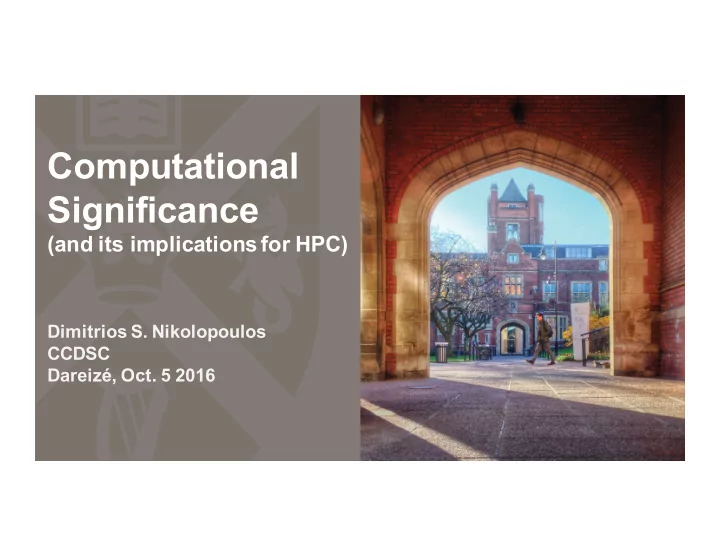

Computational Significance (and its implications for HPC) Dimitrios S. Nikolopoulos CCDSC Dareizé, Oct. 5 2016
Challenge • Transistors ü Aggressive shrinking ü Variation in performance, data retention times • Two approaches ü Mitigate it, lose performance ü Embrace it, gain performance, introduce errors • Best effort computing ü Where algorithms are inherently approximate ü Where algorithms or systems can mitigate errors
Significance-Driven Computing • Not every line of code or variable are equal ü Each has a unique contribution to the output ü Estimating this contribution needs domain expertise • Computational significance ü Value of contribution to output • Disciplined approximation • Abstraction for software ü Selectively protect execution q memory objects, tasks, threads ü Control error in the compiler, runtime, language ü Algorithm complexity control
GMRES Resilience Gscwandtner et al., CSR&D, 2015
Significance-driven GMRES Vassiliadis et al., IJPP , 2016 Chalios et al., CDT, 2015
Self-stabilizing CG • Algorithmic fault correction ü Periodic step correcting state of algorithm Guaranteed convergence ü with accurate healing step No assumptions about ü convergence rate • Heterogeneous architecture ü 1-N reliable-unreliable cores ü Designed with iso-efficiency metrics ü Healing step on reliable core Aliaga et al., PARCO, 2015
Language & runtime support • Disciplined approximation ü User controls significance, error, performance • Significance abstraction of code & data ü Binary ü Continuous • Approximate alternatives of code blocks • Examples ü OpenMP tasks q Significance ‘score’, task alternatives ü Dataflow annotations q Data criticality ü App-specific error checks
Programming Model Aliaga et al., PARCO, 2015
Simple example: Convolution Aliaga et al., PARCO, 2015
Significance-driven runtime • On-the-fly task versioning ü Controlled approximation & error checking • Quality-aware synchronization ü Flimsy barriers • Significance propagation ü Track & tune significance of task groups & chains • Multi-dimensional Optimization ü Performance, Power, Energy, Quality Vassiliadis et al., IJPP, 2016
Convolution trade-off’s Vassiliadis et al., CF, 2015 Vassiliadis et al., IJPP, 2016
Some HPC app results Vassiliadis et al., CF, 2015 Vassiliadis et al., IJPP, 2016
Lulesh error Vassiliadis et al., CF, 2015 Vassiliadis et al., IJPP, 2016
Variable-reliability memory • DRAM refresh consumes significant power ü Projected to 40%-50% in future large-memory systems • Refresh-free memories ü Additional errors ü Many mitigation options (ECC, application) • Significance-driven memory management ü Data placement & migration ü Memory reliability control
Variable-reliability memory
Relaxing refresh on an HPC server ü Divide physical memory to Reliable and Variably-Reliable Domains ü Allocate kernel to RD ü Allocate critical App data to RD ü Allow programmer to allocate heap to VRD
Application resilience ü Applications are naturally resilient, just by accessing data ü Potential for significant performance & energy gains
Application-level resilience methods • Data classification based on criticality ü E.g. low/high-frequency coefficients • Refresh by access ü Exploit the natural refresh ü Spread accesses to variably-reliable memory ü Iterative algorithms (e.g. k-means) ü Controlled anti-locality techniques (e.g. stencils) • Access-aware scheduling ü Postpone writes to variably-reliable memory ü Prioritize reads to variably-reliable memory
Refresh-by-data-access ü Accesses during window of vulnerability act as natural refresh ü Move writes late, move reads early ü Scheduling controls data refresh time ü Anti-locality optimization problem
Refresh-by-access ü Scheduling parallel tasks to control refresh time ü Improved resilience at no performance cost
HPC in a different context
Acknowledgments • The team ü Charalampos Chalios ü Kostas Tovletoglou ü Giorgis Georgakoudis ü George Karakonstantis ü Hans Vandierendonck • The support ü EPSRC (SERT) ü EU (SCoRPiO, UniServer) ü Royal Society (Wolfson Award)
Recommend
More recommend